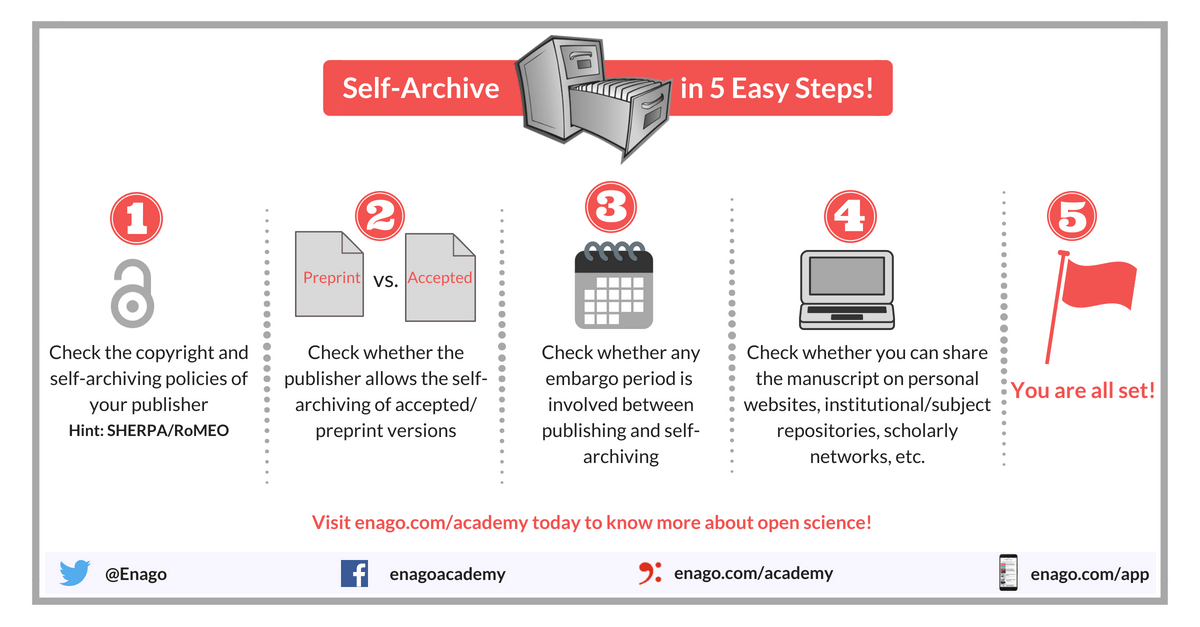A Guide to Self-Archiving for Young Research Scientists

Openly available science is becoming increasingly lauded. As publication fees for open access journals and subscription cost skyrocket, self-archiving has become a trend and for good reason—journal publication costs are soaring alongside the need to generate real research impact. Fortunately, self-archiving has emerged as a legitimate method of disseminating research. Self-arching research allows authors to post their manuscript in an institutional or personal repository, thereby allowing free and nearly immediate access to their work. This helps maximize research impact by guaranteeing open access to scientists, regardless of their ability to pay.
What’s Involved in Self-Archiving?
There are various models of publishing available, including “gold” and “green” access. While gold open access allows anyone with access to the internet to freely access research articles, it still requires that authors pay a fee. Sometimes these fees are outlandish—up to $3000 per article! As an alternative model, green open access allows authors to deposit papers in a repository. These articles may be either pre- or post-review, but all contain the valuable insights produced by researchers around the world. There are pros and cons to using such repositories. Of course, they are freely accessible and a great source of data. Unfortunately, these types of repositories often contain manuscripts whose qualities are at the discretion of those who uploaded those articles.
Nevertheless, self-archiving ultimately accelerates the process of sharing your data. How and what to self-archive is a difficult decision to make since both the publisher’s rights and the future ability to publish may be jeopardized by self-archiving too soon. For example, while the authors own a preprint version, it does not undergo peer review or other journal-style editing. Furthermore, publishers sometimes forbid the publication of previously available data, even if it’s only in a repository. Imagine trying to publish a work that has been deposited in a repository when the publisher doesn’t accept manuscripts that are available online elsewhere!
Where and How to Self-Archive
If you decide to pursue open access publishing, there are several options to consider. Open access digital object identifier (oaDOI) grants free access to articles. They do this by searching for open access versions in institutional repositories that are then linked to the DOI. In doing so, readers can look for articles by DOI and find free versions of that article!
Several other self-archiving repositories exist, including:
- arXiv, bioRxiv, PubMed Central, SSRN, and more
- Institutional repositories, such as the University of California’s California Digital Library

Publisher Policies for Self-Archiving
Before heading to the repository, be sure to check whether your target journal has any embargo period or requires a fee prior to self-archiving. This can easily be done using SHERPA/RoMEO.
Publishers, rather than journals, are often the ones to set the policies. For example, Wiley allows the preprint (submitted) version of the manuscript to be self-archived at any time, while the accepted (peer-reviewed) version may be submitted after an embargo period. Furthermore, peer-reviewed versions that are allowed to be deposited sometimes must be done so with a statement that it has been peer reviewed and a link to the journal containing that manuscript
When thinking of a repository, most publishers consider a personal website of the author, the institutional repository of the author’s University or work place, or a non-profit repository service to be acceptable places for manuscript deposition. For now, many scientists are simply waiting to see how this self-archiving process turns out for their peers. This waiting may behoove scientists as publishers work towards a publication ownership and self-archiving policy consensus.
As a young scientist the publication process can be scary, yet, trying to track down free manuscripts is even tougher! The process of journal publication has evolved recently to include self-archiving, which may enhance the research impact of authors everywhere.










We created this infographic about how to self-archive legally too. Might be of use! How to make your research open access for free and legally.